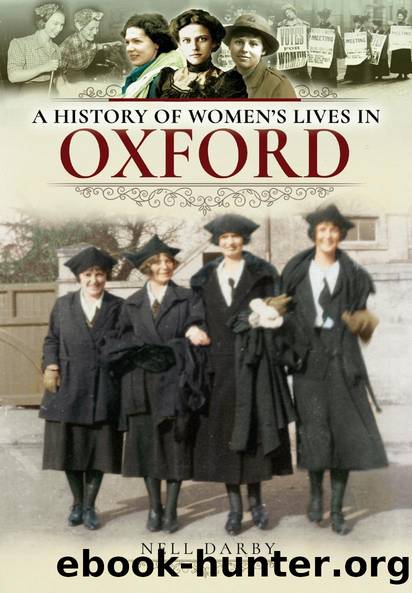A History of Women's Lives in Oxford by Nell Darby

Author:Nell Darby [Darby, Nell]
Language: eng
Format: epub
Tags: Nonfiction, Social & Cultural Studies, Social Science, Gender Studies, Women's Studies
ISBN: 9781526717870
Google: HL7lwQEACAAJ
Barnesnoble:
Goodreads: 43972545
Publisher: Pen and Sword
Published: 2019-08-15T00:30:16+00:00
CHAPTER SEVEN
Prison Life
Oxfordâs medieval prison had been replaced by a new one in the late eighteenth century, and by the start of the nineteenth it housed over 100 prisoners, divided into male and female wings. In the late 1840s and early 1850s, it was further expanded, housing double the previous number of inmates. The majority of prisoners were male â by 1856, over 200 of the imprisoned felons were male compared to women who numbered only in the twenties; the debtors, also housed in the prison, were over 100 men but again only around twenty-five women.1 This was not unusual, by any stretch, for women tended to commit fewer crimes, or serious crimes, than men, and there tended to be more leniency shown towards female offenders than male. Where women committed crimes, they were more likely to commit verbal or minor physical assaults that could be dealt with at a community level, or at petty sessions, and be punishable with a warning, the binding over to good behaviour, or a fine. Theft was an offence committed both by men and women, with the latter often stealing items of dress, or small items related to dressmaking, from local shops. In 1856, for example, three women were charged with stealing nine mantles and a length of ribbon from the shop of William Boleman at 9 High Street; they had asked Mr Boleman for bonnets, and while he was looking for someone, stole the other goods. Two of the women, Corty and Roberts, were serial offenders; they had also stolen five baby robes, another five mantles, and five parasols, from William Guy at 47 Cornmarket Street â and passed some of the goods onto Smith to sell. Again, the two women had asked William Guy for bonnets, and his assistant sent them into the shopâs showroom. The assistant then went out to get more products, leaving the women alone â and after they had gone, it was found that some of the goods were missing. Two other women, Emma Gilkes and Sarah Green, gave evidence against the accused females.2
Oxford had its own Female Penitentiary and House of Refuge, aimed at rescuing fallen women â described in a newspaper of 1862 as âthis excellent institutionâ.3 Yet residents didnât know much about it; indeed, in 1854, it was noted that âit may to very many be unknownâ.4 When plans had been put into motion to establish it back in the early 1830s, it was noted that it would be âthe only institution in Oxford for the present improvement and reformation leading to the eternal happiness of an unfortunate and numerous class of femalesâ.5 The Penitentiary aimed at the outset to prevent fallen women from either becoming prostitutes or committing suicide â this being, of course, a criminal offence at the time. In Oxford, the unfortunate women who the Penitentiary aimed to help were divided into two classes:
The one, those who are seduced from places of service; the other, children of Oxford parents, who associate with
Download
This site does not store any files on its server. We only index and link to content provided by other sites. Please contact the content providers to delete copyright contents if any and email us, we'll remove relevant links or contents immediately.
A Rome of One's Own by Emma Southon(252)
The Evidence of Things Not Seen by James Baldwin(247)
Warrior Queens & Quiet Revolutionaries by Kate Mosse(245)
Executive Order No. 9066: The Terrible Injustice Of 1942 by Sollace Freeman(234)
The Explorers by Amanda Bellows(221)
A Wider Type of Freedom: How Struggles for Racial Justice Liberate Everyone by Daniel Martinez HoSang(200)
Respectability and Reform by Tara M. McCarthy(186)
Liberty's Dawn: A People's History of the Industrial Revolution by Emma Griffin(173)
The Grey Eagles of Chippewa Falls by John E. Kinville(167)
Rethinking White Societies in Southern Africa by Duncan Money(165)
Letters From London by Julian Barnes(163)
The Crosswinds of Freedom by James MacGregor Burns(160)
A Troublemaker May Surprise (The Troublemaker Series Book 2) by Genta Sebastian(149)
Evolution of Slavery Through the Ages: A Comprehensive World History of Slavery by PRESS VERITY(145)
Continental Strangers by Gemunden Gerd;(138)
A Teacher's Guide to Ladies of Liberty by Cokie Roberts Amy Jurskis(137)
The Slave Ship, Memory and the Origin of Modernity by Martyn Hudson(133)
Hunger Dark Pen by Dark Pen(126)
Beware the Masher by Kerry Segrave(124)
